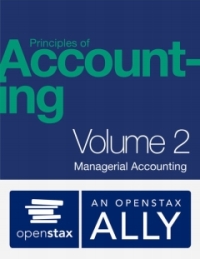Question
Tidex Company is a manufacturer of cleaning detergent. Product Cleanx is manufactured on a weekly basis. The following standards have been established to produce 10,000
Tidex Company is a manufacturer of cleaning detergent. Product Cleanx is manufactured on a weekly basis. The following standards have been established to produce 10,000 litres of Cleanx.
Standard direct labour hours of 5,000 to mix 10,000 litres of detergent Standard direct labour rate per hour: $18 Actual direct labour hours consumed: 5,500 Actual direct labour rate: $18.45 Calculate the Labour Quantity Variance (LQV).
|
| A) $11,475 Favourable |
|
| B) $9,000 Unfavourable |
|
| C) $2,475 Favourable |
|
| D) $2,475 Unfavourable |
A company developed the following per-unit standards for its product: 5 kilograms of direct materials at $3 per kilogram. Last month, 1,000 kilograms of direct materials were purchased for $2,900. Also last month, 700 kilograms of direct materials were used to produce 135 units. What was the direct materials quantity variance for last month?
|
| A) $75 unfavourable |
|
| B) $75 favourable |
|
| C) $900 unfavourable |
|
| D) $900 favourable |
Bridgeware Company has a materials price standard of $2.50 per kilogram. Four thousand kilograms of materials were purchased at $2.40 a kilogram. The actual quantity of materials used was 3,500 kilograms, although the standard quantity allowed for the output was 3,400 kilograms. Bridgeware Company's materials price variance is

|
| A) $400 U. |
|
| B) $400 F. |
|
| C) $350 U. |
|
| D) $300 F. |
Blue Fin Co. produces a product requiring 10 kilograms of material at $1.50 per kilogram. Blue Fin produced 10,000 products during 2016 resulting in a $30,000 unfavourable materials quantity variance. How much direct material did Blue Fin use during 2016?
|
| A) 120,000 kilograms |
|
| B) 100,000 kilograms |
|
| C) 200,000 kilograms |
|
| D) 145,000 kilograms |
The standard number of hours that should have been worked for the output attained is 8,000 direct labour hours and the actual number of direct labour hours worked was 8,400. If the direct labour price variance was $8,400 unfavourable, and the standard rate of pay was $18 per direct labour hour, what was the actual rate of pay for direct labour?
|
| A) $17.00 per direct labour hour |
|
| B) $15.00 per direct labour hour |
|
| C) $19.00 per direct labour hour |
|
| D) $18.00 per direct labour hour |
Step by Step Solution
There are 3 Steps involved in it
Step: 1

Get Instant Access to Expert-Tailored Solutions
See step-by-step solutions with expert insights and AI powered tools for academic success
Step: 2

Step: 3

Ace Your Homework with AI
Get the answers you need in no time with our AI-driven, step-by-step assistance
Get Started


